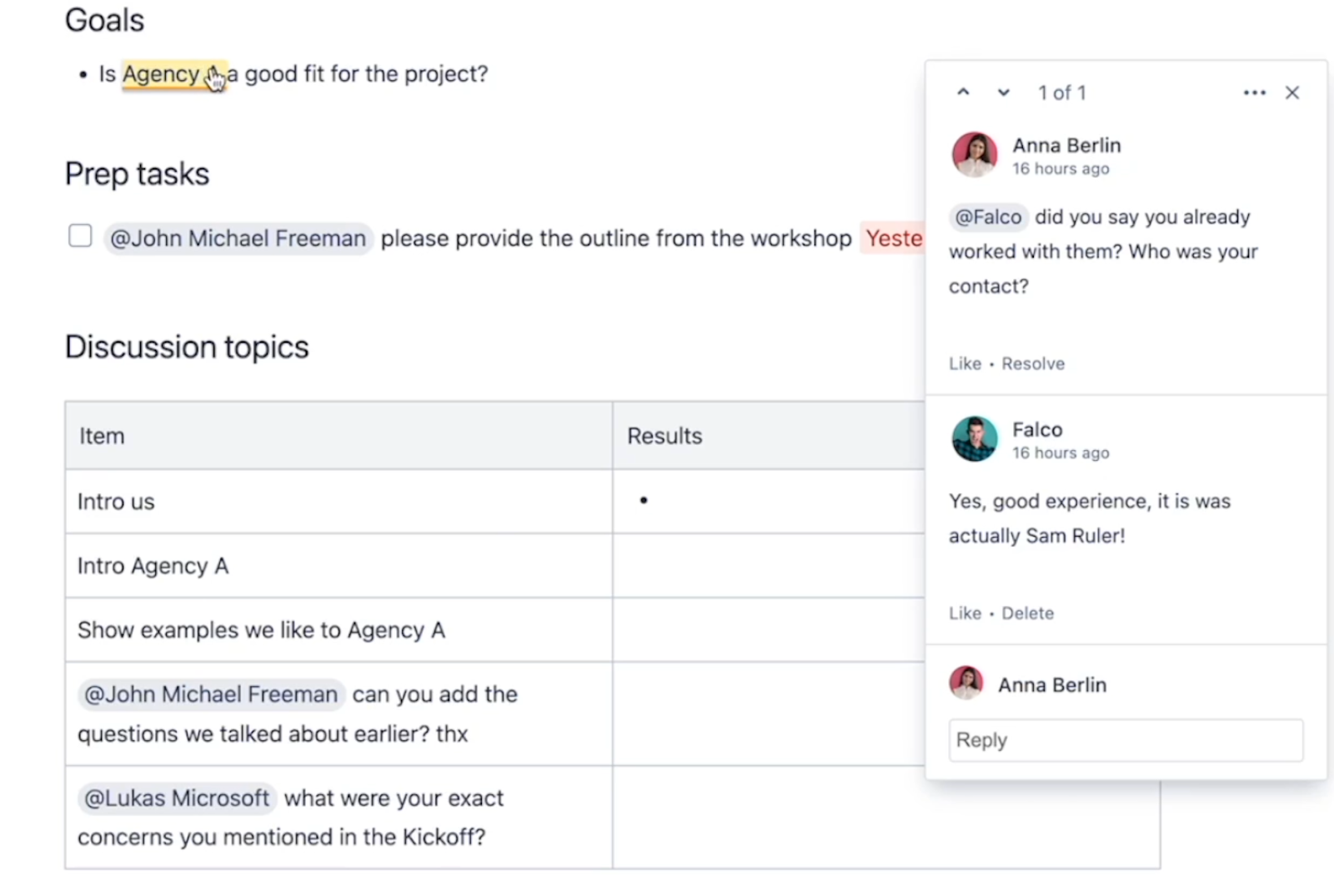8 Confluence best practices for highly effective meetings
By integrating Meetical with Confluence best practices, you can create an inclusive and transparent meeting culture that everyone will love.
From a technical knowledge base to a collaborative platform, Confluence has steadily evolved into a content collaboration hub for every team in your company – and for good reason. Confluence addresses a critical issue plaguing most organizations, especially those who have adopted remote or hybrid work: fragmented communications.
On average, eight meetings per week takes place across all employee types and company sizes. And studies have shown that 30% of meeting participants don’t complete action items because they can’t remember key information after a meeting. To keep track of these tasks and ensure a more seamless collaboration process, it’s crucial for teams and leaders to have ongoing conversations about what tools they should use to help run their meetings.
The solution for many teams that use Confluence is one of the Meeting Notes Templates for more unified communication. We’ll go over more Confluence best practices like this to run highly effective meetings that can be a game changer for you and your company. (Spoiler alert: it’s all about careful meeting design and using the right productivity tools to support you!)
1. Keep the participant list short but include spectators using @mentions
While keeping the participant list short is a best practice for keeping a meeting productive, it’s equally important to avoid making anyone feel excluded and unheard – sometimes referred to as meeting FOMO (“fear of missing out”).
Great leaders orchestrate meetings in a way that inspires 100% participation. To do this, you first need to understand the difference between participants and spectators and weed out the spectators. Participants are those who actively contribute and are empowered to make decisions and represent important stakeholders. Spectators are often marked as “optional” attendees on the calendar invite. Like a fly on the wall, they mostly observe what’s going on and might be there because of meeting FOMO. But in the end, they don’t make productive contributions.
Sure, it’s great to have everyone included in every meeting, but it’s not always feasible. By limiting the number of optional attendees and CC’ing them using @mentions on Confluence, these team members can jump into the conversation at their convenience. Including a meeting overview and project statements on Confluence should also help everyone stay in the loop without being forced to participate.

2. Create an agenda and make it open to contributions
When you have a set meeting agenda, you tend to make the most out of the session. Confluence meeting agendas are built around discussion topics and goals that can be open for contributions. This way, every member feels accountable for the outcome, and goals are addressed more transparently.

You can use a Confluence meeting page to collaboratively plan the agenda ahead of time. Remember, action items with @mentions and due dates can also be used for preparation tasks. Having a structured meeting and being able to collaborate on that structure not only improves productivity but also the outcomes.
3. Link meeting agendas in calendar invites
If a meeting agenda cannot be found quickly, people can’t make contributions. But more importantly, they fail to prepare for the meeting. Because preparation is key for highly effective meetings, you should link meeting agendas in calendar invites. You can do this by copy-pasting the meeting page link in the meeting description.
The easiest way to implement this best practice is by using the Meetical Meetings app. It offers seamless Confluence Calendar integration for Google Workspace and Confluence Outlook integration for Microsoft 365. This integration helps everyone find and create meeting notes quickly and efficiently, all from one place.

You can add the meeting page with just a few clicks from an integrated Confluence meeting calendar or install the Confluence browser extension or Outlook add-in. This integrates Confluence page creation in your existing calendar app.

And for recurring meetings, you can turn on automation, which will auto-create pages for these meetings days in advance and link the page on the calendar invite.

Linking the meeting notes page manually or with automation helps everyone find the agenda easily, pull information from past meetings when they need to, and stay on top of their assigned tasks. The full featured version of the app can be installed from the Atlassian Marketplace.
4. Get expertise from different teams
Gaining additional insights and knowledge from other departments leads to better and more accurate results. So when you want to run something by a team that you don’t normally work with on a daily basis, Confluence makes it easy by tagging anyone within the company. For example, you can consult with a product manager from a different team to ask for their thoughts on a potential solution for a new feature. Simply select the text, create a comment, and tag a person using the @mention to get their expertise.

5. Phrase agenda items as questions
This is a psychological hack that will improve how you use Confluence. Instead of writing vague phrases and notes that only you can understand, contextualize the discussions with detailed questions.
For example, if the agenda is to understand whether an agency can offer a solid ROI for link building, you can write “link building agency evaluation” in the agenda table. But this might not offer a complete picture to other participants who don’t follow your trail of thoughts. Instead, try reframing your questions:
- “Does the agency have demonstrable case studies for similar projects?”
- “Will the investment be justifiable in the long run?”
Asking questions can spark discussions among team members and give clarity to exactly what you’re thinking. Instead of just wondering, you start finding solutions. This helps both you and your team members come to conclusions and reach meeting goals faster.
6. Take both personal and collaborative meeting notes
It’s important to take personal notes and collaborative notes with the team at the same time.
Your personal notes can be much more creative and will help you learn and retain information in the best way for you. Not to mention, it also helps you stay active and attentive during the meeting. On the other hand, a Confluence page is more useful to record team decisions and action items and for recording important results from discussions.
Action items should always be kept visible for everyone to see, as well as decision logs with their corresponding reasons so that everyone’s on the same page.
Decision logs help team members measure progress and understand how exactly each meeting reaches its outcome. The more robust and transparent you are in terms of maintaining Confluence meeting notes, the smoother your meetings will run.

7. Review previous meetings and action items
Productive meetings don’t work in a vacuum – they must be tied back to the previous meetings and developments to establish context. For this, you can create open action items and assign them with the due date of the new meeting. This way, whenever you’re ready to start a new meeting, you’ll have reports ready from the previous sessions.
Including a Task Report Macro directly on your meeting pages helps avoid switching back and forth between different pages. You can use the Meetical App to include a report of all open action items in any recurring meeting automatically.

Surveying topics discussed earlier helps create a cohesive meeting culture and participants feel encouraged to be involved in the process because they know what’s going on. Reviewing completed and open action items at the beginning of each meeting also creates a sense of progress.
To implement this best practice, use the Task Report Macro in Confluence to create a list of open and complete action items in a space or nested in a parent page.
If you use Meetical’s automation to create your weekly meeting notes pages, the macro will automatically be included and show all open action items within a meeting series.
8. Make status meetings async (mostly)
Running asynchronous status meetings is one of the most effective Confluence best practices. Despite being essential, status meetings can be rather boring. Keeping the live check-ins brief – say, 15 minutes or so – and then keeping the rest async can boost productivity. Studies show that in meetings that are no longer than 15 minutes, 91% of attendees pay attention. This number steadily declines until it reaches only 64% in meetings over 45 minutes.

Create a table for team members to input their data and get them into the habit of sharing detailed plans, highlights, and low points of the week. By following detailed status reports, you can conclude weekly status meetings sooner and spend more time focusing on other goals. And if you love automation as much as we do, have the participant table automatically generated for you, just in time.
About Meetical
Meetical takes the impressive premise of Confluence meeting notes and extends its functionality with calendar integrations, seamless page editing, and instant sharing. With an automated and comprehensive note-taking tool, you can increase the productive minutes in a meeting and reduce the hours spent discussing the same things.
In a nutshell
A lot can be said about a company in the way it runs its meetings. By integrating Meetical with Confluence best practices, you can create an inclusive and transparent meeting culture that everyone loves to be part of.


